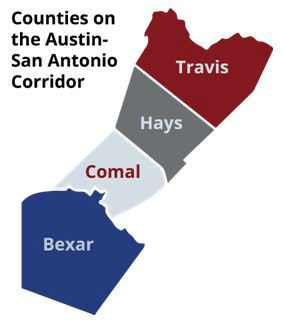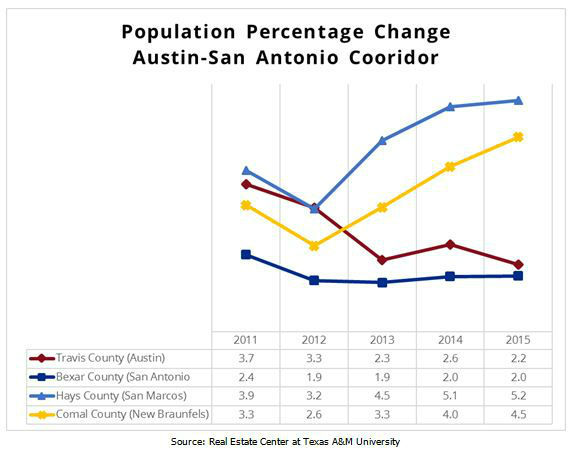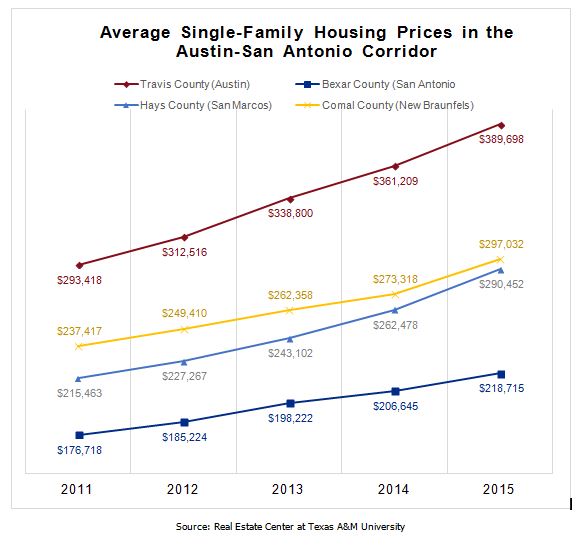Thursday, August 25th, 2016 and is filed under Construction, Economy, General, Housing Affordability, Housing Market, Housing Starts

Dallas and Fort Worth are different cities, with separate cultures, separated by approximately 60 miles. These two cities are, nonetheless linked by infrastructure (rail and roads) into one gigantic region known as the Metroplex. But D-FW might not be the only metroplex in the state. A March 2016 article in the Austin-American Statesman posed the question:“Will Austin-San Antonio become the Next DFW1?” The article quoted Steve Adler, Austin’s mayor and an analyst, who indicated that the long stretches of development along Interstate 35, combined with the rate of growth in Hays County (south of Austin) and Comal County (north of San Antonio) could lead to an eventual megaplex.
James P. Gaines, chief economist, Real Estate Center at Texas A&M University, said the idea of an Austin-San Antonio metroplex isn’t new2. During the 1990s, then San Antonio mayor Henry Cisneros suggested that very thing. Gaines said Cisneros was a little ahead of his time with his thinking, but his words are prophetic.
“Though the economies of the two principal metros are different and have different bases, proximity and some common elements – high-tech in Austin and bio-medical technology in San Antonio – give rise to connectivity between the two towns,” Gaines noted.

Growing Population in the “Connector Counties”
Part of the driver behind a Central Texas megalopolis is the population growth in the counties linking Austin and San Antonio. The Austin metro has been touted as one of the fastest growing; in 2015, the population in Travis County, as a whole, was 1.17 million, versus the 1.06 million just a few years earlier, in 20113. Yet in comparison, the percentage increase in population in both Travis County and Bexar Counties (the county seats of which are Austin and San Antonio, respectively), paled in comparison to the population jumps in Hays and Comal Counties. In fact, growth actually slowed in Travis and Bexar Counties.

One possible reason for these metrics is domestic migration. The chart below shows that, while Travis and Bexar Counties experienced a decrease in domestic migration, neighboring counties saw an increase. Particularly interesting is that Comal County, of which New Braunfels is the county seat, experienced a domestic in-migration boost of 26.2% I n 2015.

As Population Rises, So Do Housing Costs
One factor behind the population increase in Hays and Comal Counties could be housing prices. In 2015, the average housing price in Travis County was more than $389,000. Meanwhile, in Hays County, just to the south (San Marcos is the county seat), the average housing price was just above $290,000.

Also interesting is that Bexar County registered the lowest housing prices among the four counties during the four-year period between 2011-2015. But realistically, someone will not likely buy a house in the San Antonio metro, and make the 80-mile or so commute to Austin – at least not yet. There is, however, no doubt, that people do commute from as far south as Comal County to the south side of Austin on a daily basis.
The Future of the Megalopolis
There is little doubt that the San Antonio and Austin metros are growing, both outward and toward one another. However, unlike Dallas and Fort Worth, which are linked by two interstate roads and one state highway (not to mention rail), Austin’s and San Antonio’s sole link, for now, is Interstate 35. Still, San Antonio mayor Ivy Taylor and her counterpart in Austin understand that the Central Texas region is growing quickly. Both mayors, in fact, are focusing on infrastructure issues (travel, water and so on) that will be impacted over the next several decades4.
The full development of a (Austin-San Antonio) metroplex is still some time away,” Gaines observed. “But it’s most definitely getting closer.”
[1] James Barragan and Marty Toohey (March 24, 2016). “Will Austin-San Antonio becomes the Next DFW?” Austin-American Statesman. Retrieved from http://www.mystatesman.com/news/news/local/will-austin-san-antonio-become-the-next-dfw/nqrFw/
[2] Interview.
[3] Population Data. (2015) Texas A&M University Real Estate Center. Retrieved from https://www.recenter.tamu.edu/data/population/
[4] Barragan & Toohey.